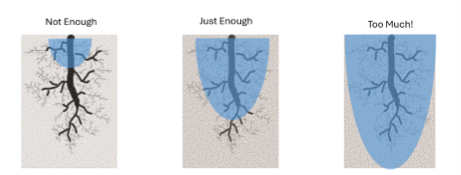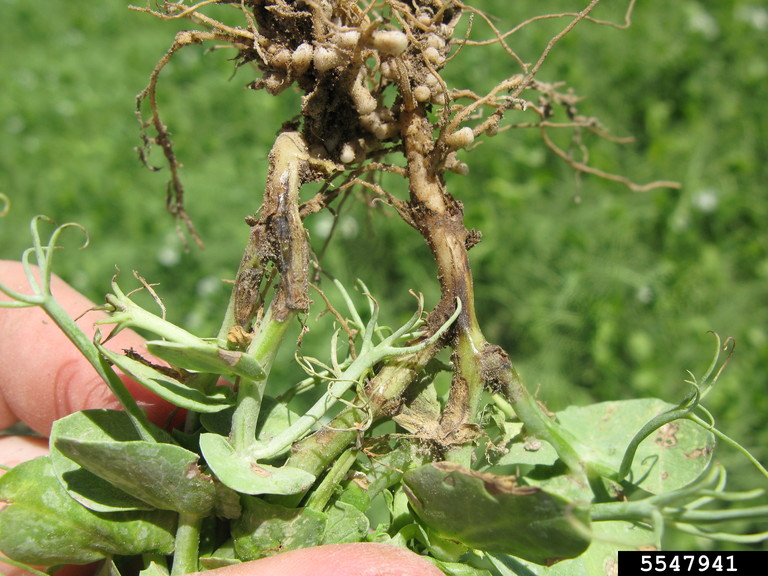Watering strategies to keep a garden productive
Keeping a garden properly irrigated requires knowing how much water to use and the right way to water.

As a state that shares a border with four Great Lakes, Michigan’s access to water creates excellent growing conditions for many crops. Between precipitation and irrigation from groundwater or municipal water sources, many Michigan gardeners often have no difficulty getting the necessary supply of freshwater. Getting water into the garden efficiently can conserve water, provide plants with the correct amount of irrigation, and save money for gardeners who pay water bills.
Watering settings

The simplest way to water a garden is with a hose. If you purchase a garden hose nozzle with multiple settings, it’s important to know the best use for each (Photo 1).
The soaker setting provides a larger amount of water at a lower pressure and is most functional when leaving the nozzle along the drip zone of trees and shrubs as an alternative to a soaker hose.
Misting is ideal for propagating and watering newly germinated plants with a gentle flow of water that will not dislodge soil or plants.
The shower setting most closely resembles rainfall and is a good option for watering established gardens.
The jet setting is not recommended for watering plants, as the high-pressure blasts away soils and can put holes in leaves. However, this strong force of water is useful to spray off high numbers of aphids from woody plants.
Measuring how much water is needed
Once you’ve figured out the correct setting to water your garden, Michigan State University Extension recommends estimating the correct amount of water that is needed. Gardens need approximately 1 inch of water weekly depending on received precipitation and plant characteristics.
Measuring your water input is a wise decision to avoid overwatering your garden. Here's a simple math problem to water your garden more efficiently. Start by measuring how much water your hose nozzle delivers. Use a 5-gallon bucket and a timer.
For example:
- Hose nozzle setting: Shower
- Time to fill 5-gallon bucket: 2 minutes
- This means your hose delivers 2.5 gallons per minute (5 ÷ 2 = 2.5).
Now apply this to your garden:
- Garden size: 100 square feet
- Water needed: 1 inch of water per week
- 1 inch of water over 1 square foot = 0.623 gallons (known value)
- Water needed per week: 100 × 0.623 = 62.3 gallons per week
- Watering time needed: 62.3 ÷ 2.5 = about 25 minutes per week
In lawns and vegetables with shallow roots, you may want to spread out watering over three to four days with about 6 to 8 minutes per session. If you are watering a tree, you can water the entire amount at one time, if you water slowly. Allow the water to soak in deeply and avoid runoff.
This 1-inch-per-week guideline applies to average temperatures and established plants. The ideal volume of water and frequency of irrigation depends on species, growth stage, rooting depth and climatic conditions. During hot or dry weeks, you may need to water more often (but for the same amount of time each session).
It is best to water in the morning during summer. This wets the foliage while dew is already present, decreasing the total hours contributing to disease risk. Additionally, this increases soil moisture in preparation for when the plant’s water demand is the highest. New plantings or seeds may require watering more often. Seeds may need to be misted more than once a day if conditions cause the soil to dry out too fast. The majority of root activity occurs in the upper regions of the root zone for many crops, and maintaining soil moisture in this region is crucial.
Why it’s important to water correctly
Providing too little irrigation causes a deficit of soil moisture in the plants root zone, leading to drought stress and wilt. This causes most plants to prioritize resources for survival instead of growth and reproduction. In vegetables, this will reduce yield. On the other hand, overwatering is also detrimental. Over-applying irrigation wastes water and has the potential to leach your soil’s nutrients. This carries critical components, like nitrogen and phosphorus from soil nutrients or fertilizer sources, away from the plant and deeper into the soil, where they are more likely to become a contaminant of groundwater.
Both underwatering and overwatering can induce stress. Providing just enough water improves resilience, promoting growth and productivity.
In addition to wasting water, too much irrigation will cause the garden to suffer. Roots need oxygen in the soil for respiration. If the soil is overhydrated for more than a short time, it interferes with oxygen and nutrient uptake (Photo 2). Even on a hot day, it is possible to overwater the garden.

Watering too much or wetting the plant’s foliage too often creates ideal conditions for disease, fungi, and molds to thrive, while limiting respiration. Overly wet soils increase susceptibility to root rots caused by pathogens (Photo 3). Watering in the evening leaves moisture on the leaves overnight, which increases the risk for fungal and bacterial spores to enter the leaf surface.
Too much moisture from the gardener or from rainfall creates ideal conditions for foliar diseases to thrive and may eventually lead to blights or spots that weaken plants. The Michigan State University Plant and Pest Diagnostic Lab includes a list of several common plant diseases.

How do I know if my garden is dry enough to need water?
You’ll need to get your hands a bit dirty, or wear gloves, to determine if the garden is drying out. First, dig down 4-6 inches with a trowel. Then, grab a handful of soil and squeeze. If water drips out: Don’t water, you may need to wait a couple of days. If it holds together in a ball: You can wait another day. If it crumbles apart: Time to water. Soil texture can influence how you estimate moisture by feel. For an in-depth procedure of estimating soil moisture by feel and appearance, see “Estimating Soil Moisture by Feel and Appearance” from the U.S. Department of Agriculture Natural Resources Conservation Service
Watch your soil and your plants for signs indicating dryness. Wilting plants are often a clue but do not always mean dry soil. Certain pathogens also cause plants to wilt. If there has been lots of rain, the wilting could also be due to excessively wet soil. Take the time to get to know your soil and your plants' needs. This will result in a healthier garden and a better harvest.



 Print
Print Email
Email